If you buy through our links, we may earn an affiliate commission. This supports our mission to get more people active and outside.Learn about Outside Online's affiliate link policy
The 6 Best Women’s All-Mountain Skis of 2026
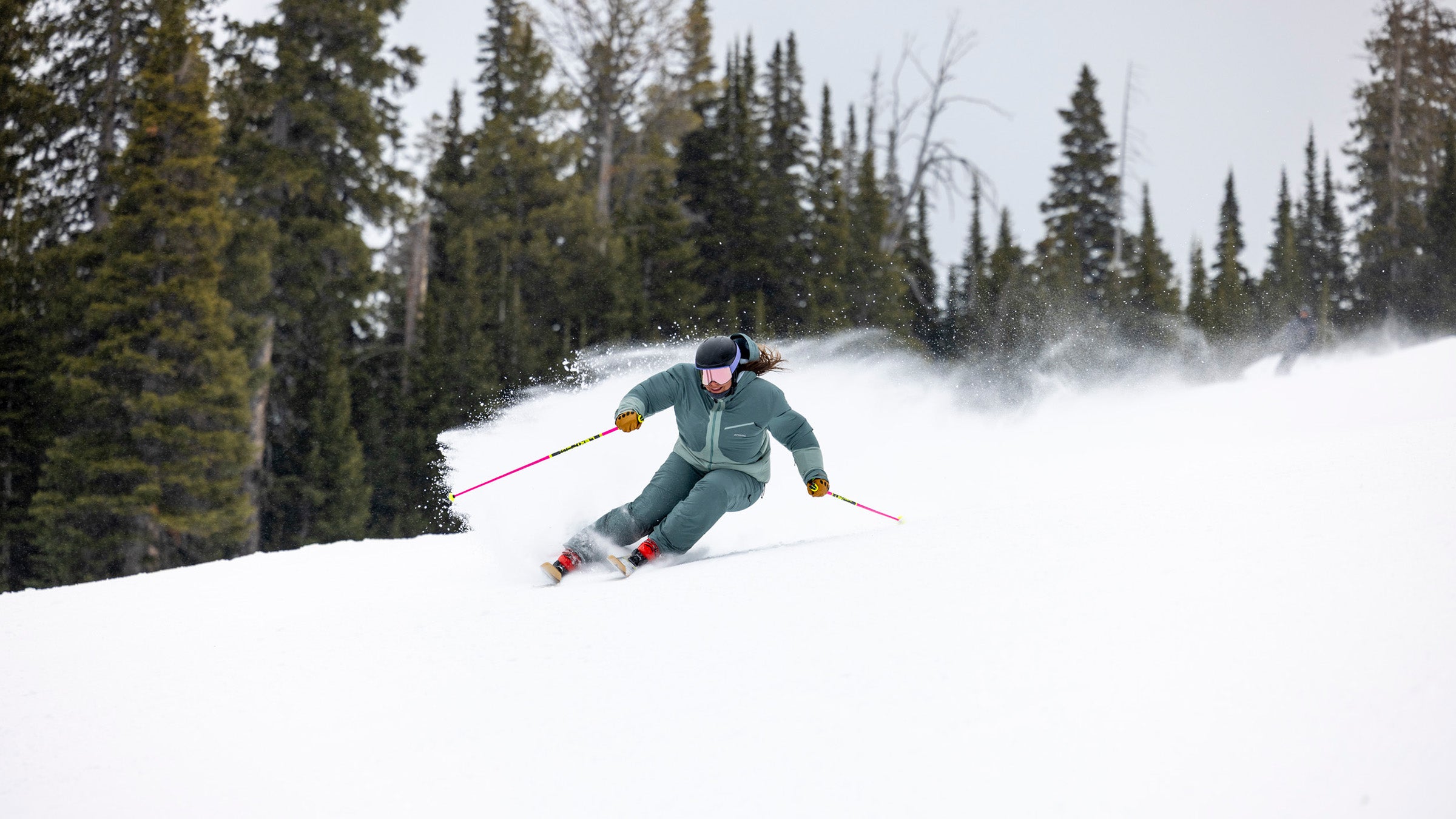
Tester Zoe Mavis, a professional ski instructor at Big Sky, rips down a groomer on a test lap. (Photo: Colton Stiffler)
Table of Contents
Think of the best women’s all-mountain skis as Swiss Army Knives—multitaskers eager to please in changing terrain and conditions. Many of these skis have multidimensional personalities that thrive on contradiction: They’re aggressive enough to charge yet mellow enough cruise, and they’re equally at home trenching on groomers as they are hunting for soft pockets off-trail.
Of the 16 women’s all-mountain skis we tested at our annual SKI Test at Big Sky, Montana, six models rose to the top after impressing our crew of 12 experienced female testers the most. Whether you’re a weekend warrior in the East or a pass-holder in the Rockies or beyond, these women’s all-mountain skis are designed to be the only pair you truly need—your ultimate mountain companions that seamlessly adapt to whatever type of snow or terrain is underfoot.
At a Glance: Best Women’s All-Mountain Skis
- Best in Test: Rossignol Arcade W 94 ($800)
- Best for Most: Head Kore Ti 99 W ($749)
- Best Value: Salomon QST 94 ($700)
- Best for Crud: Nordica Santa Ana 97 ($750)
- Best for Firm Snow: Blizzard Black Pearl 94 ($800)
- Best for Soft Snow: Atomic Maven 94 CTi ($750)
More Skis We Recommend
- Stöckli Nela 96 ($1,329)
- Armada Reliance 92 Ti ($825)
- Fischer Ranger 96 ($800)
- Völkl M7 Mantra W ($930)
- Liberty Horizon 92 ($750)
The Reviews: The Best All-Mountain Skis for Women
Of the 16 women’s all-mountain skis we tested at our annual SKI Test in Big Sky, Montana, these six stood out as top performers. They earned the highest marks across nine scoring criteria, with especially strong results in versatility and crud performance—the two performance characteristics we prioritize when reviewing all-mountain skis. Read more about our testing process here.
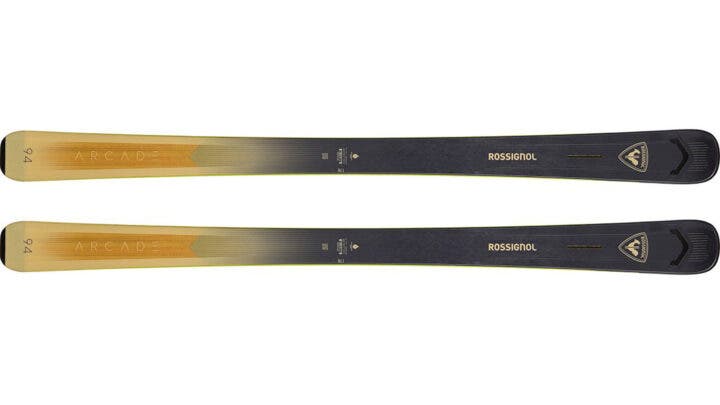
Best in Test: Rossignol Arcade W 94
Dimensions: 138-94-127
Lengths: 154, 162, 170, 178 cm
Pros and Cons
⊕ Super energetic
⊕ Loves to be up on edge
⊗ A little stiff for moguls
⊗ Not the floatiest board in powder
After the narrower-waisted Arcade 88 won Best in Test in our unisex frontside category last season, female testers were thrilled that Rossignol expanded the Arcade line to include women’s models like the Arcade W 94. Earning the highest scores in six out of 10 criteria—versatility, playfulness, responsiveness, quickness, stability at speed, and carving—it nailed the category for being a ski that truly does it all.
It’s not, however, a generalist with no true personality: This ski wants to turn and burn. With a snappy 16 meter turning radius (178 cm length), full wood core, and vibration-dampening metal laminates, it’s nimble, energetic, and responsive, and it gets on edge the second you think about turning it. “It skis like a frontside ski but has the width to do a lot more,” said Vail, Colorado-based tester Lauren Engle, who owns Vail’s Outdoor Divas ski shop. “Quick as a whip edge to edge,” echoed tester Krista Crabtree, a race coach who certainly knows her carvers.
Testers also noted that it would be an excellent teaching tool for those who aspire to improve, as it pulls you into a perfect arc with just the tilt of your ankle. Bumps, trees, groomers, crud—it energetically dove into it all. The only minor quibbles were that it might not be the floatiest board on a powder day, because that flat tail (oh, that tail!) is meant to finish turns strong, and the stiff longitudinal flex can feel burly in the bumps. Read the full review here.
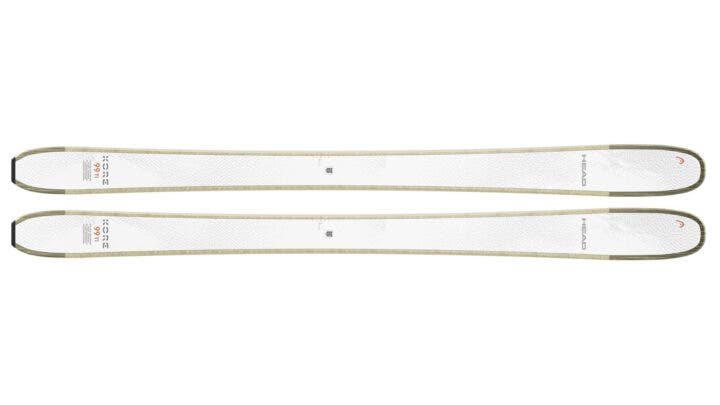
Best for Most: Head Kore Ti 99 W
Dimensions: 130-98-120 mm
Lengths: 153, 163, 170, 177 cm
Pros and Cons
⊕ Easy to ski
⊕ Great in powder
⊗ Lacks playfulness
⊗ Not the quickest
Yep, you read that little Ti next to the model name right—the new line of Head Kore skis has two sheets of crud-busting, groomer-gripping, vibration-damping Titanal in it. And testers loved it.
The construction update was a brave move from Head, as the previously lightweight Kore line has been their most successful in recent memory; but it turns out, a little extra heft was exactly what was missing from the previous models. The stability the new Kore 99 Ti W gains from the metal far outweighs the slight loss in quickness, maneuverability, and playfulness that comes from the additional weight underfoot. “It has a race-heritage feel in an all-mountain package,” noted tester Lauren Engle.
That’s not to say it takes a racer to ski it, however: It scored top marks in forgiveness, and testers noted it’s approachable for intermediates on up. A strong tip drives it straight down the fall line, and a soft tail is easy to disengage and zip through bumps. It’s floaty, too, besting the other all-mountain skis we tested in that criteria as well. When it came to hard-snow grip, testers scored it middle of the pack among winners, noting it prefers softer snow to East Coast boilerplate.
“This ski is a thing of beauty,” reported Aspen, Colorado-based tester Renée Cernichiari. “It’s extraordinarily approachable and just a fun ski. You can trust it to charge, or be lazy through the bumps and swish your turns. It does it all beautifully.”
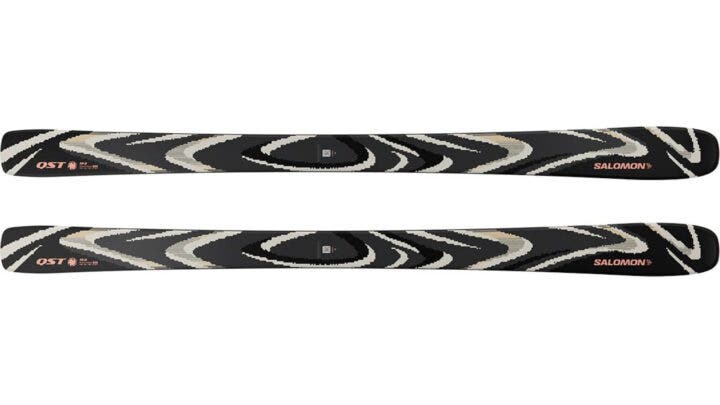
Best Value: Salomon QST 94
Dimensions: 132-94-118 mm
Lengths: 156, 164, 172, 180, 188
Pros and Cons
⊕ Surfy and smeary
⊕ Quick underfoot
⊗ Prefers soft snow
⊗ Carving isn’t intuitive
Salomon has revamped their QST line several times since its first iteration, and the QST 94 represents yet another era—one in which all skis are truly unisex. For those who are worried that might mean “burly,” rest assured: Our female testers loved it, noting that it feels energetic, balanced, dependable, and nimble, and put it in the winner’s circle for being supremely easy to ski.
The QST 94 features a new shape and materials, including a layer of basalt fibers that replaces the carbon and flax used in previous models; a new injected cork and TPU insert in the tips and tails’ rocker, cleverly called “Cork Damplifier,” reduce vibration and make it feel calm in chunder without adding heavy metal.
Testers found it to be a playful and forgiving ride, and noted it would be a confidence-inspring platform for intermediates on up. While the new QST 94 was designed with a more squared-off and directional tail than previous iterations to improve its edge grip and hard-snow performance, testers felt it was still best at pivoting and smearing, probably owing to the steep rocker profile.
Correspondingly, testers noted that it preferred soft snow and chattered on hardpack, but in big open bowls, like the kind that Big Sky, Montana, is famous for, it was a true delight. “It’s a rhinestone cowgirl,” said Telluride-based veteran tester Kelli Gleason. “It has a flashy, confident, and stylish approach to the mountain.”
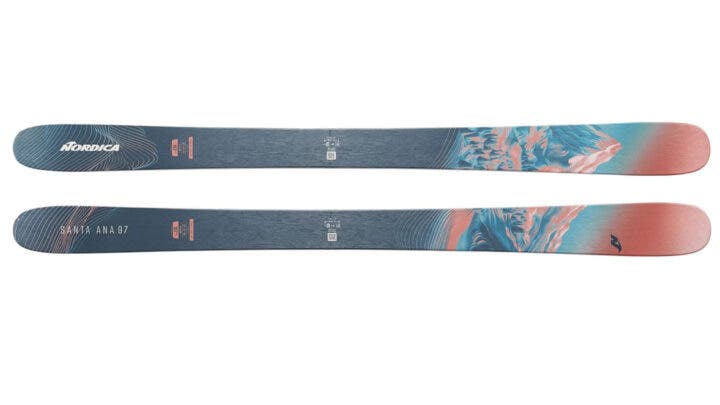
Best for Crud: Nordica Santa Ana 97
Dimensions: 127-97-115 mm
Lengths: 150, 155, 161, 167, 173, 179 cm
Pros and Cons
⊕ Crushes crud
⊕ Stable and dependable
⊗ Not for the timid
⊗ Stiff and heavy
Some skis are the life of the party, and others will always be your safe ride home. Nordica’s Santa Ana 97 is the latter, with a solid, consistent, dependable feel that never lets you down.
Of course, that also led a couple testers to yearn for a little more energy and agility, but most appreciated the Santa Ana 97’s consistency. They noted that because it’s so predictable, it would be a good teaching tool for less experienced skiers, but it really shines at speed and when driven hard, and it had no upper limit in terms of ability or speed. Its stuck-to-the-snow feel—thanks to a sheet of metal and an elastomer vibration dampening strip in the core—earned it the highest scores in our crud performance criteria, with testers noting it gave them supreme confidence to take it to eye-watering speed. “This ski is a crusher,” said Colorado-based tester Renée Cernichiari. “She is eager to please. Roll her over on edge and put your ass to the ground, or bop through bumps and fluff.”
It’s not the most forgiving women’s all-mountain ski, but it plays nicer at shorter lengths. All in all, an excellent daily driver for those who value a ski with some backbone over a playful ride.
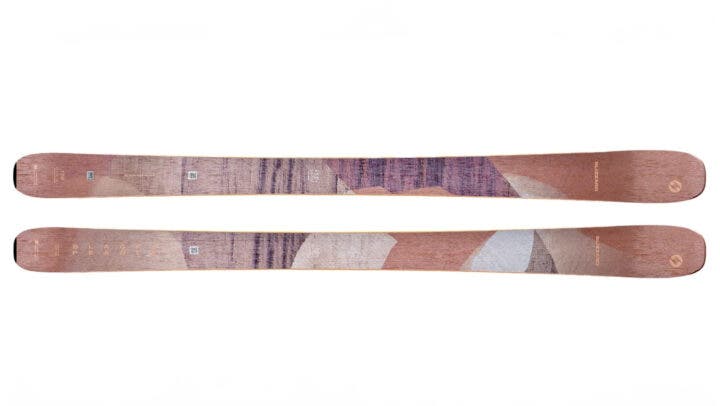
Best for Firm Snow: Blizzard Black Pearl 94
Dimensions: 131.5-94-113.5 mm
Lengths: 152, 158, 164, 170, 176 cm
Pros and Cons
⊕ Grips on hardpack
⊕ Quick and stable
⊗ A bit stiff for moguls
⊗ Not a ton of float
The Black Pearl line has been a perennial favorite, and the 94-millimeter-waisted version (new last year) is no exception. It’s a fun pistol of a ski that’s quick edge to edge and has a reassuring heft that blasts through crud and mank.
The key to this ski’s success is two strategically placed metal laminates that add stability, grip, and precision underfoot and on the edges, where you need it most, and a rocker profile that eases turn initiation and exit. A beach and poplar wood core that varies in stiffness at the tip and tail helps it tip and rip instantly, and gives it enough backbone for when you want to really give ’er.
A few testers felt it was lacking in liveliness, which also means it’s not ideal for moguls, but most agreed that was a small price to pay for stability. It’s also not the floatiest ski in the category, but it earned top marks in the hard-snow performance criteria, which our ex-racers appreciated in spades. It’s ideal for Eastern or Western skiers who ski all over the mountain but still need that hard-carving feeling on the groomed runs. “If you stand on it, it will reward you,” said Courtney Harkins, the director of marketing and communications for the U.S. Ski and Snowboard Team in Park City, Utah.
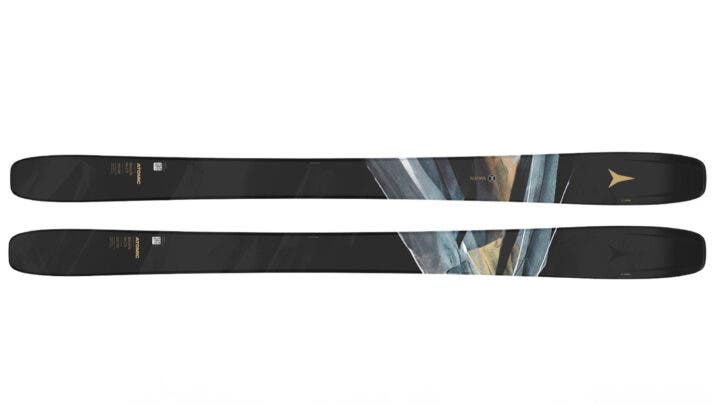
Best for Soft Snow: Atomic Maven 94 CTi
Dimensions: 126-95-111.5 mm
Lengths: 151, 158, 165, 172 cm
Pros and Cons
⊕ Nimble
⊕ Listens to driver input
⊗ Thrives only in soft-snow habitat
⊗ Skittish in crud
Atomic redesigned the Maven 94 CTi for 2026, replacing some of the Titanal with carbon and adding more tail rocker—resulting in a ride that’s similar to its wider sister, the Maven 103 CTi, also in the winner’s circle this year. Testers approved, noting that it’s easy on the legs, capable in all terrain, and one of the best boards for powder in this category.
In our test at Big Sky, the Maven 94 CTI scored high marks for playfulness, responsiveness, and flotation, with testers commenting that it has more of a new-school, pivot-and-slarve vibe than its predecessor. It’s the kind of ski that wants to pop off of every berm, making even a cat track a playground of opportunity. “Pivoted beautifully in the trees and bumps,” said Utah-based skier Avery Pesce, who’s also the VP of merchandising at Boston Ski & Tennis. “Smooth and stable on groomers, and they roll easily in and out of turns. Super approachable, too.”
All that playfulness did come with a cost, however, as many testers noted it’s a bit chattery at speed and deflected easily off of push piles and death cookies. Others felt it almost too forgiving, running the risk of getting overpowered by heavy or aggressive skiers. But for those who ski mostly soft snow, it’s a nimble playmate with a freeride spirit that will inject every run with more fun.
More Skis We Recommend
The following all-mountain skis are models that excel in specific areas like carving or forgiveness, offering strong alternatives for skiers with specific performance preferences.
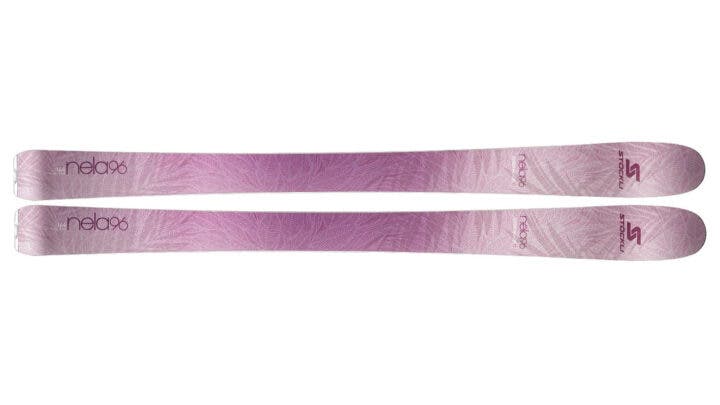
Stöckli Nela 96
Dimensions: 134-96-121 mm
Lengths: 156, 164, 172 cm
Pros and Cons
⊕ Excellent edge contact
⊕ Listens to driver input
⊗ Thrives only in soft-snow habitat
⊗ Stiff and damp
The Nela 96 is versatile for a Stöckli ski, which are known for their penchant to precisely slice and dice hardpack like a mandolin, but testers felt it was less accessible and playful compared to our other top picks. That said, what this ski does do—crush crud and stay stuck to the snow at top speeds—it does very, very well. The 96 is Stöckli’s widest model for women, which is on-brand for Swiss carving machines, and it’s best suited for experts who know how to find their edges. It’s damp, calm, and smooth, and its heft lends a confidence that goaded testers to go faster, regardless of the conditions. It’s not easy on the quads, but for those willing to work, it returns that effort tenfold.
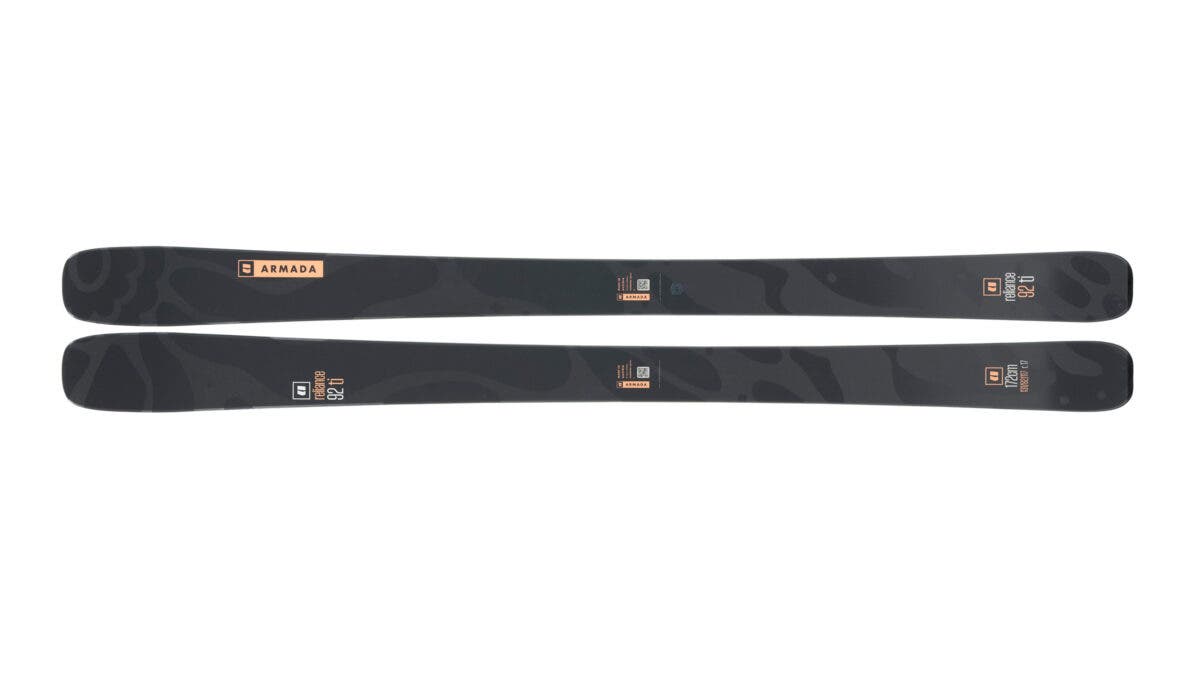
Armada Reliance 92 Ti
Dimensions: 130-92-116 mm
Lengths: 156, 164, 172, 180 cm
Pros and Cons
⊕ Precise on hardpack
⊕ Loves to push the speed limit
⊗ Doesn’t tolerate poor technique
⊗ Directional only; wants to be on edge
Armada has always been a company focused on real skiers on the hill—which is why it resonated immediately with freeskier kids back in the early 2000s. And when those kids grew up, Armada listened, creating more directional skis designed to carve on-piste. The Reliance 92 Ti is one such ski, earning high marks in our test at Big Sky in the hard-snow integrity, crud performance, and stability at speed scoring criteria. Testers called it a rocket ship that is exciting to experts but might feel punishing to intermediates. With vibration-dampening metal and a stiff flex, the Reliance 92 Ti is best enjoyed by aggressive skiers who know how to arc ’em; it received middling scores in forgiveness. Testers also dinged it in playfulness, owing to that directional feel. But for women who want an all-mountain ski they can really stand on, especially in hardpack, the Reliance 92 Ti is a solid contender.
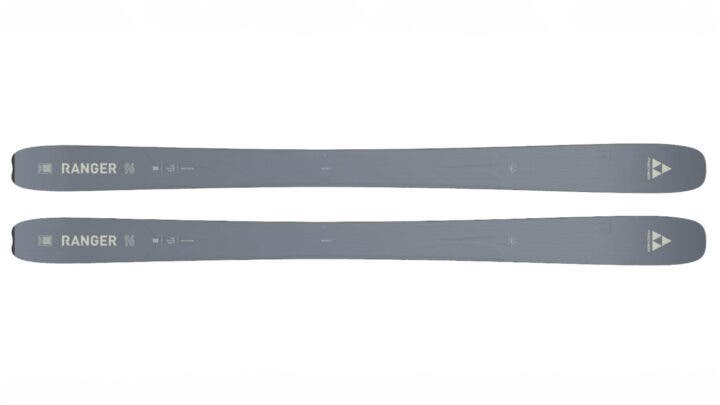
Fischer Ranger 96
Dimensions: 128-96-119 mm
Lengths: 159, 166, 173, 180, 187 cm
Pros and Cons
⊕ Floaty in powder
⊕ Quick-turning
⊗ Prefers soft snow only
⊗ Nervous at high speeds
For off-piste powder-hunters who want a reasonably waisted soft-snow specialist, the Fisher Ranger 96 is your ski. It’s also extremely adaptable to all ability levels, with ample tip rocker to initiate turns easily and an easygoing vibe that caters to those who want the freedom to adventure all over the mountain without any fear of doing it wrong. As for what it’s lacking, well, let’s just say its best attributes are also its biggest weaknesses. Testers felt it was a little too soft to have serious bite, lacking stability in high-speed turns, and not as steadfast as they would have liked in crud, despite a layer of vibration-dampening metal. But all in all, testers agreed that it’s a great teaching tool for lesser experts and a solid adventurer for experts who are soft-snow connoisseurs.
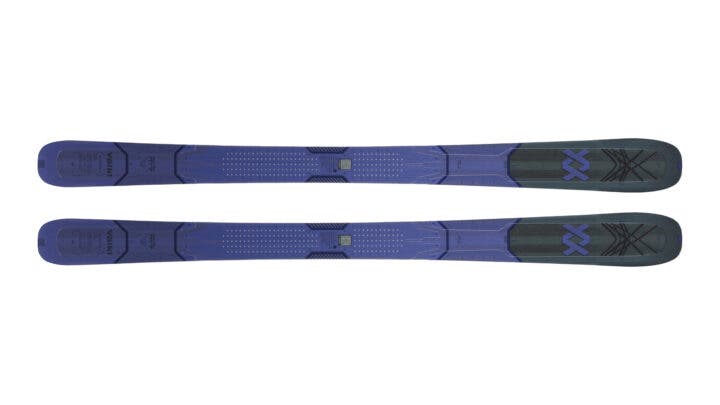
Völkl M7 Mantra W
Dimensions: 139-96-121 mm
Lengths: 149, 156, 163, 170, 177 cm
Pros and Cons
⊕ Bites like a bulldog on ice
⊕ Has no speed limit
⊗ Too precise to be playful
⊗ Not for the weak
There is a cost, sometimes, in making a ski that’s utterly unflappable at speed and carves railroad tracks so deep, those in your wake need to mind the trenches. Such is the case with the Völkl M7 Mantra W (formerly known as the Secret 96). Testers loved it, scoring it high in stability at speed and hard-snow integrity, but with an asterisk: It’s not for the faint of heart or weak of quads. This ski is for a strong carver who isn’t afraid of speed—and for that particular skier, it will never disappoint. For those who sometimes enjoy a Sunday cruise without buckling their boots? Not so much. Built with metal, carbon, and a full wood core, it’s a stiff and precise carving machine.
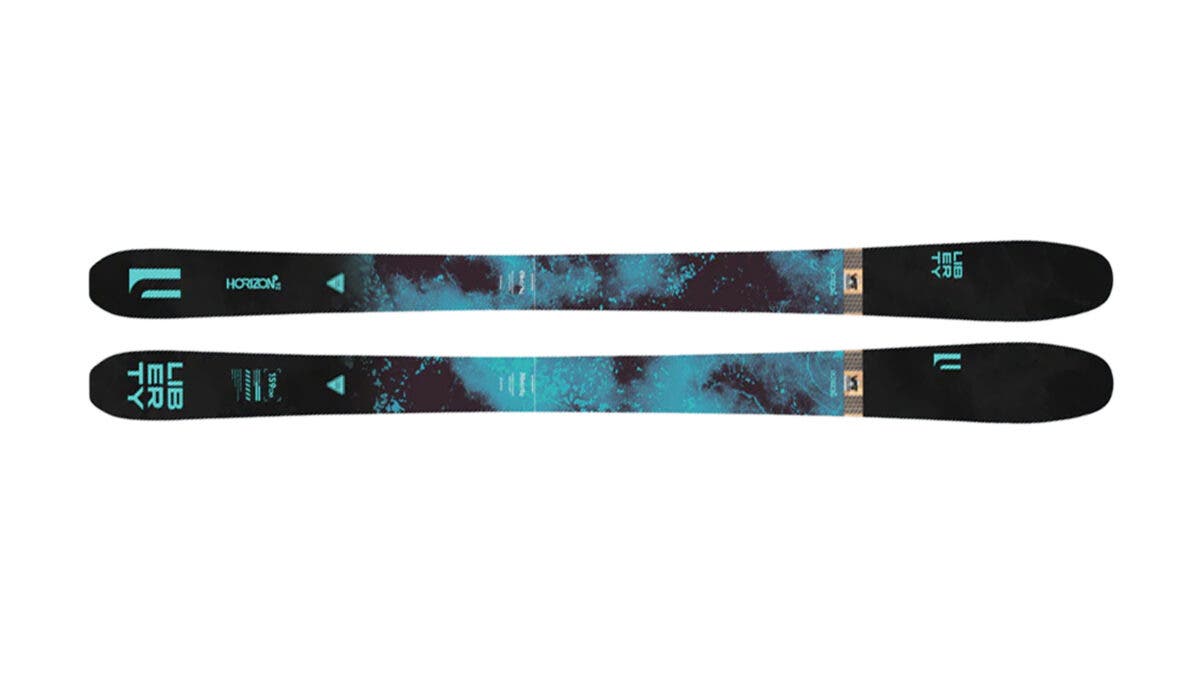
Liberty Horizon 92
Dimensions: 130-92-116 mm
Lengths: 145, 152, 159, 167 cm
Pros and Cons
⊕ Loves to play in soft snow
⊕ Approachable and easy for all
⊗ Lacks bite on hard snow
⊗ Prefers lower speeds
In a category Liberty is calling “directional freeride,” the Horizon 92 is an easygoing, accessible ski ideal for softer Western snow, which makes sense coming from the Avon, Colorado-based ski brand. Liberty places a full sheet of metal strategically underfoot for grip and tapers it in the tips and tails for ease and playfulness. A narrower tail releases easily in tight trees and bumps, which is where this ski truly shines. Testers definitely felt the Horizon 92’s looser lands more on the freeride than the directional side, however, noting that it gets nervous at high speeds and turns its nose up at hardpack. They also felt it was better for lesser experts, easy to steer at slow to moderate speeds and eager to suck up bumps and dive into the soft pockets in the trees. While it’s not an all-mountain ski for advanced and expert skiers who value precision and stability on firm snow and at high speeds, it’s a forgiving option that reminds us skiing should be fun, not hard work.
Best Women’s Skis Comparison
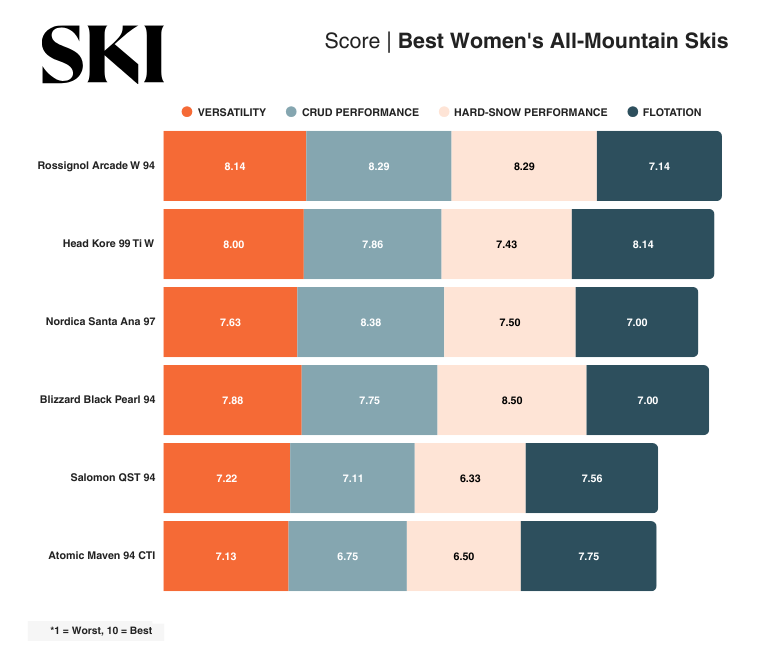
About SKI Test
- Number of skis tested: 16
- Number of testers: 12
- Testing location: Big Sky, Montana
- Tester range: Ages 27- 52 | Height: 5’2” – 6’ | Weight: 112-180 lbs
Each year, SKI’s editorial team conducts one of the most rigorous and trusted all-mountain ski tests in the industry. At the 2025 SKI Test in Big Sky, Montana, 12 experienced skiers from across the country tested 16 women’s all-mountain skis in real-world resort conditions. To reduce subjectivity, all testers skied each model on the same day, in the same conditions, and submitted digital scorecards evaluating each ski across nine criteria:
- Versatility
- Crud Performance
- Stability at Speed
- Responsiveness
- Carving
- Quickness
- Forgiveness
- Playfulness
- Flotation
When judging the best all-mountain skis for women, we place the greatest emphasis on versatility and crud performance—two key indicators of a top-tier all-mountain ski. The eight winners on this list earned consistently high marks across all categories, especially those two. The skis included in the “More Skis We Recommend” section are models that excel in specific areas like playfulness or forgiveness, offering strong alternatives for skiers with specific performance preferences. Learn more about our testing methodology and scoring criteria here.
Why You Can Trust Us
Our ski reviews are the result of the largest, most rigorous on-snow test in the industry. We never charge brands to participate and don’t guarantee coverage—our annual SKI Test is a fully independent editorial project designed to deliver objective, in-depth reviews. Our 12 expert testers include ski instructors, ski patrollers, ski shop owners, hardgoods buyers, ski technicians, and race and freeride coaches. We handpick this crew for their professional expertise and intentionally include a range of body types, ages, and home mountains to reflect the broader ski community. Bottom line: There’s no pay-to-play here—just honest feedback from people who know skis. Meet some of our veteran testers below:
Kimberly Beekman
Age: 49 | Height: 5′4″ | Weight: 112 lbs
Kimberly Beekman has been testing skis and writing gear reviews for longer than she’d like to admit. She’s a former editor of SKI and freelance contributor to both SKI and Outside. She lives in Steamboat Springs with her wonderful daughter and terrible cat.
Avery Pesce
Age: 42 | Height: 5′6″ | Weight: 138 lbs
Originally from the North East, Pesce now lives in Midway, Utah, but still calls the ski areas of Vermont and New Hampshire home. She’s an expert skier with an aggressive style that she applies to any and all types of terrain and snow conditions. As the head ski buyer for Boston Ski & Tennis in Newton, Mass., she knows a thing or two about skis—how they’re built, how they perform, and who they’re best suited to.
Courtney Harkins
Age: 34 | Height: 5′8″ | Weight: 135 lbs
Courtney Harkins grew up ski racing, starting on the icy slopes of New England and finishing at the University of Colorado at Boulder. She now lives in Park City, Utah and works as the director of marketing and communications for the U.S. Ski & Snowboard Team. When she’s not traveling with the team, her home mountain is Deer Valley Resort, where she loves to arc turns on groomers, but also knows all the secret spots for days-old powder.
Frequently Asked Questions
What is an all-mountain ski?
All-mountain skis are designed to take on the entire mountain, from groomed runs to moguls to steep-and-deep freeride terrain. They usually feature a waist width ranging from 85 to 100 millimeters, tip rocker, and some tail rocker. It’s hard to beat the versatility of an all-mountain ski, though these skis can be too wide for those who spend the majority of their time on groomers, and too narrow for those who ski mountains blessed with regular and bountiful snowfall.
What is the best all-mountain ski for women?
For 2026, our testers named the Rossignol Arcade 94 W the best all-mountain ski for women. It’s an incredibly versatile all-mountain ski that handles everything from groomers to bumps and crud confidently. Energetic and easy to turn, it’s a great choice for intermediates to experts.
What’s the difference between men’s and women’s skis?
In truth, most skis are unisex and not gender-specific. Many brands produce the ski with the exact same construction technologies for both genders, but often create two different top sheets to appeal to men vs. women. In general, men and women can often use the same ski but may want to choose different lengths depending on their height, weight, and their skiing style/ability. A handful of brands design true women’s skis with construction tweaks for female physiology. These skis tend to be available in shorter lengths (170 cm down to 150 cm), and often use softer, lighter materials.
At SKI, we test all skis intended for women—including unisex models in approachable lengths (162 cm or shorter). Many of the skis on this list are unisex models that our female testers loved. If you prefer a slightly longer, heavier ride, don’t worry about the “unisex” label. Every ski here, whether women’s-specific or unisex, has been rigorously tested by women and recommended for women.
How long do skis last?
With proper care and regular tuning, skis can last for 200-300 days on snow depending on the size and aggressiveness of the skier. Larger skiers and people who are harder on their equipment will not get as many days on snow before the wood core, edges, or other aspects of the ski become compromised. Bindings should be tested by a professional ski tech every season, and replaced when they do not meet standardized norms.
How long should my skis be?
As a general rule of thumb, the shorter the ski, the easier it is to turn and control. So if you’re a beginner, reach for a ski that’s about chin-height. More advanced skiers often choose skis that are as long as they are tall, since longer skis provide more stability at speed and float in deep snow. So the best ski length for you will depend on your height, your skill level, and what type of skiing you hope to do. A ski-shop employee can help point you in the right direction.
Note that ski length is relative. Narrow carving skis tend to ski longer than their length because they feature more effective edge, while powder skis tend to ski shorter than their length because they feature more rocker in the tip and tail. Learn more here.
How long do skis last?
With proper care and regular maintenance performed by a professional ski tech, skis can last for 200 to 300 days on snow, depending on the size and aggressiveness of the skier. Larger skiers and people who are harder on their equipment will not get as many days on snow before the wood core, edges, or other aspects of the ski become compromised.





